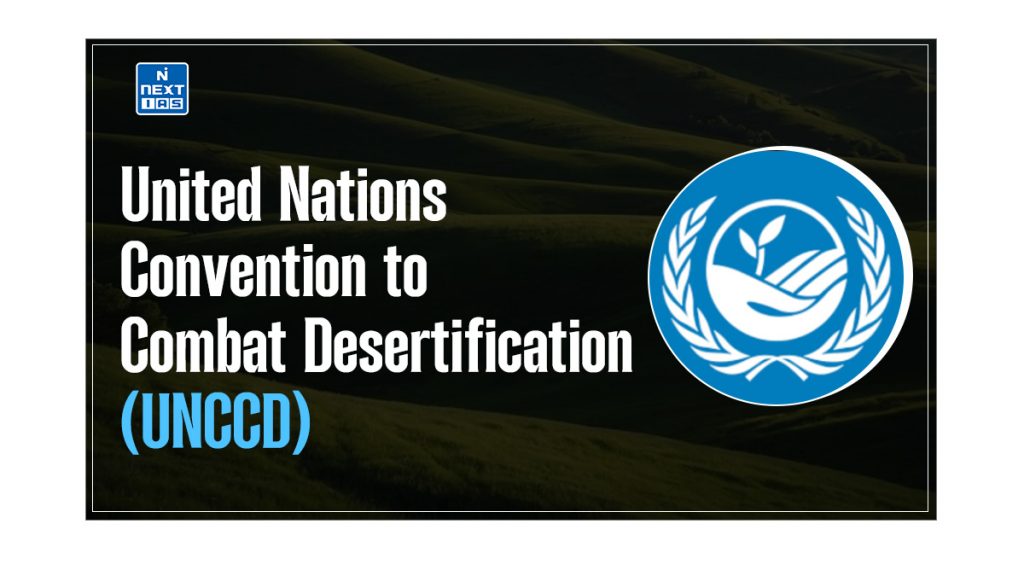
The United Nations Convention to Combat Desertification (UNCCD) is an international agreement focused on addressing land degradation and mitigating the effects of drought. Its significance lies in being the only legally binding framework dedicated to combating desertification, promoting sustainable land management, and fostering global cooperation to restore affected ecosystems. This article aims to study in detail the key features, objectives, and impact of the UNCCD on combating desertification and climate change.
About United Nations Convention to Combat Desertification (UNCCD)
- The United Nations Convention to Combat Desertification (UNCCD) combats desertification and mitigates the effects of drought through national action programs that incorporate long-term strategies supported by international cooperation and partnership arrangements.
- It works in countries facing severe drought-like situations, particularly in Africa.
- It is the only convention stemming from a direct recommendation of the Rio Conference’s Agenda 21, adopted in Paris (France) on 17 June 1994 and entered into force in December 1996.
- It is the only internationally legally binding framework set up to address the problem of desertification.
- The Convention is based on participation, partnership, and decentralisation, the backbone of good governance and sustainable development.
- It has 197 parties, making it near universal in reach.
- To help publicise the Convention, 2006 was declared “International Year of Deserts and Desertification,” but debates have ensued regarding how effective the International Year was in practice.
Objectives of United Nations Convention to Combat Desertification (UNCCD)
The major objectives of the United Nations Convention to Combat Desertification (UNCCD) are as follows:
- To forge a global partnership to reverse and prevent desertification/land degradation.
- To mitigate the effects of drought in affected areas to support poverty reduction and environmental sustainability.
Key Features and Framework of the UNCCD
The key features and the framework of the UNCCD are as follows:
Legal Framework of the UNCCD
The United Nations Convention to Combat Desertification (UNCCD) is a legally binding international agreement focusing on combating desertification, land degradation, and drought (DLDD) through sustainable land management.
The legal framework of the UNCCD includes:
- Global Framework: It sets global objectives for combating desertification and mandates international cooperation to meet these goals.
- National and Regional Action: Countries must develop national, regional, and sub-regional action plans to address land degradation.
- Reporting Mechanism: The framework includes a monitoring and reporting mechanism for member states to share progress and challenges in combating desertification.
Obligations of Member States
The member states of the UNCCD have several obligations under the convention:
- Develop National Action Programs (NAPs): To combat desertification, each country must develop and implement strategies tailored to its specific needs and conditions. These plans should address both environmental protection and sustainable land use.
- Integrate Policies: Countries must integrate measures to prevent desertification into their broader national policies for development, agriculture, water management, and environmental protection.
- Capacity Building and Research: Member states must promote capacity-building programs and support research on the causes and impacts of desertification and drought.
- Financial and Technical Support: Developed countries are expected to provide financial and technological assistance to developing nations, particularly those most affected by desertification, to support sustainable land management efforts.
- Periodic Reporting: Countries are required to report their progress in combating desertification to the UNCCD Conference of the Parties (COP) regularly.
National Action Programs (NAPs)
National Action Programs (NAPs) are the core of the UNCCD’s implementation strategy. These are country-specific strategies that outline the actions nations will take to achieve the convention’s objectives.
Some key elements of NAPs include:
- Assessment of Land Degradation: Countries must assess the extent and causes of desertification and land degradation in their territories.
- Policy and Legal Reforms: NAPs often include recommendations for policy reforms and institutional changes to promote sustainable land management.
- Sustainable Land Management Strategies: The NAPs focus on promoting practices that prevent further land degradation, such as soil conservation, water management, and reforestation.
- Participation of Local Communities: Countries are encouraged to involve local communities, farmers, and stakeholders in the development and implementation of NAPs, ensuring the integration of traditional knowledge and practices.
- Monitoring and Evaluation: NAPs require clear benchmarks and mechanisms for monitoring progress and evaluating the effectiveness of strategies.
Land Degradation Neutrality (LDN)
- Land Degradation Neutrality (LDN) is a condition in which further land degradation (loss of productivity caused by environmental or human factors) is prevented, and already degraded land can be restored.
- The Parties to the Convention have defined land degradation neutrality (LDN) as ” a state whereby the amount and quality of land resources, necessary to support ecosystem functions and services and enhance food security, remain stable or increase within specified temporal and spatial scales and ecosystems.”
Benefits of Land Degradation Neutrality (LDN)
- As land is fixed in quantity, there is an ever-increasing competition to control land resources and capitalise on the flows of goods and services from the land.
- Land Degradation Neutrality (LDN) represents a paradigm shift in land management policies and practices.
- It is a unique approach that counterbalances the expected loss of productive land with the recovery of degraded areas.
- This can cause social and political instability, fueling poverty, conflict and migration.
Implementation of Land Degradation Neutrality (LDN)
- The implementation of LDN requires multi-stakeholder engagement and planning across scales and sectors, supported by national-scale coordination that utilises existing local and regional governance structures.
- UNCCD and the UN Environment Programme (UN Environment) came together to mark the United Nations General Assembly’s adoption of the 2030 Agenda for Sustainable Development.
- To date, over 120 countries have engaged with the LDN Target Setting Programme, and considerable progress has been made since the 2030 Agenda was adopted in 2015.
15th COP to United Nations Convention to Combat Desertification (UNCCD)
- The COP15 concluded recently with a global pledge to boost drought resilience and invest in land restoration for future prosperity with the theme “Land Life Legacy: From scarcity to prosperity”.
- As an outcome of the COP, the member states agreed to establish an Intergovernmental Working Group on Drought for 2022-2024 to support a shift from reactive to proactive drought management and agreed and committed to accelerate the restoration of one billion hectares of degraded land by 2030.
- “Drought in Numbers, 2022” was released at the COP15 which called upon the world to prioritize drought preparedness and resilience.
- Other significant outcomes of the COP 15 included three key declarations:
- Abidjan Call issued by the Heads of State and Government to boost long-term environmental sustainability,
- Abidjan Declaration on achieving gender equality for successful land restoration, and
- COP15 “Land, Life and Legacy” Declaration, which responds to the findings of the UNCCD’s flagship report, Global Land Outlook 2.
- The Delhi Declaration of 2019, signed during the 14th Conference of the Parties (CoP) of the United Nations Convention to Combat Desertification (UNCCD), advocated for improved land access and management while highlighting the importance of transformative initiatives that are sensitive to gender considerations.
Role of the UNCCD in Combating Climate Change
- Link Between Desertification and Climate Change: Desertification exacerbates climate change by releasing stored carbon from degraded lands, while climate change accelerates desertification through increased temperatures and droughts, creating a vicious cycle that worsens land degradation and affects ecosystems.
- UNCCD Complements Global Agreements: The UNCCD supports the Paris Agreement by promoting sustainable land management and land restoration, which enhance carbon sequestration and climate resilience.
- Its goal of Land Degradation Neutrality (LDN) aligns with global climate objectives, contributing to reduced greenhouse gas emissions and improved ecosystem health.
- Contribution of Sustainable Land Management: Sustainable land management (SLM) practices, such as afforestation and soil conservation, help capture carbon, improve land health, and build resilience against climate impacts.
- These practices make lands better carbon sinks and support communities in adapting to climate change.
Conclusion
The UNCCD plays a crucial role in global efforts to combat desertification and climate change. By promoting sustainable land management and striving for Land Degradation Neutrality (LDN), it addresses the dual challenges of land degradation and climate impacts. The recent outcomes from COP15 and ongoing global partnerships underscore the importance of integrated strategies for land restoration and drought resilience. Through continued commitment and collaboration, the UNCCD aims to enhance environmental sustainability and improve the livelihoods of communities affected by desertification and drought.
Frequently Asked Questions (FAQs)
What is Desertification?
Desertification is the process by which fertile land becomes increasingly arid and unproductive, often due to climate change, deforestation, and unsustainable land use.
Is UNCCD legally binding?
The UNCCD is the only legally binding framework set up to address desertification and the effects of drought. There are 197 Parties to the Convention, including 196 country Parties and the European Union.





